
Illustrative Math Alignment: Grade 6 Unit 1
Expressions and Equations
Lesson 4: Practice Solving Equations and Representing Situations with Equations
Use the following Media4Math resources with this Illustrative Math lesson.
| Thumbnail Image | Title | Body | Curriculum Nodes |
|---|---|---|---|

|
Math Example--Ratios, Proportions, and Percents--Solving Proportions: Example 35 | Math Example--Ratios, Proportions, and Percents--Solving Proportions: Example 35TopicRatios, Proportions, and Percents DescriptionThis example demonstrates how to determine if two parallelograms are similar using proportions. Two parallelograms are shown, with the first having dimensions 6 and 9, and the second having dimensions 15 and 22.5. The problem requires setting up a proportion to check for similarity: 6 / 9 = 15 / 22.5. After simplifying, the ratios are equal, confirming that the parallelograms are indeed similar. |
Proportions |
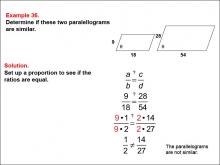
|
Math Example--Ratios, Proportions, and Percents--Solving Proportions: Example 36 | Math Example--Ratios, Proportions, and Percents--Solving Proportions: Example 36TopicRatios, Proportions, and Percents DescriptionThis example demonstrates how to determine if two parallelograms are not similar using proportions. Two parallelograms are shown, with the first having dimensions 9 and 28, and the second having dimensions 18 and 54. The problem requires setting up a proportion to check for similarity: 9 / 18 ≠ 28 / 54. After simplifying, the ratios are not equal, concluding that the parallelograms are not similar. |
Proportions |
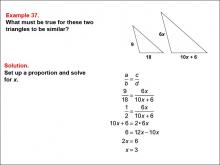
|
Math Example--Ratios, Proportions, and Percents--Solving Proportions: Example 37 | Math Example--Ratios, Proportions, and Percents--Solving Proportions: Example 37TopicRatios, Proportions, and Percents DescriptionThis example illustrates solving a proportion problem using similar triangles with algebraic expressions. Two triangles are shown, one with side lengths 9 and 18, and the other with expressions 6x and 10x + 6. The problem requires setting up a proportion to determine the value of x for which the triangles are similar: 9 / 18 = 6x / (10x + 6). Solving this equation leads to x = 3. |
Proportions |
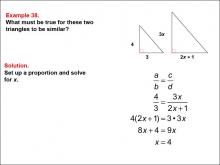
|
Math Example--Ratios, Proportions, and Percents--Solving Proportions: Example 38 | Math Example--Ratios, Proportions, and Percents--Solving Proportions: Example 38TopicRatios, Proportions, and Percents DescriptionThis example demonstrates solving a proportion problem using similar right triangles with algebraic expressions. Two right triangles are shown, one with side lengths 4 and 3, and the other with expressions 3x and 2x + 1. The problem requires setting up a proportion to determine the value of x for which the triangles are similar: 4 / 3 = 3x / (2x + 1). Solving this equation leads to x = 4. |
Proportions |
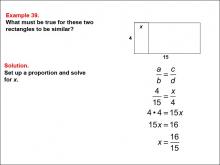
|
Math Example--Ratios, Proportions, and Percents--Solving Proportions: Example 39 | Math Example--Ratios, Proportions, and Percents--Solving Proportions: Example 39TopicRatios, Proportions, and Percents DescriptionThis example illustrates solving a proportion problem using similar rectangles with an unknown side length. Two rectangles are shown, one with side lengths of 4 and x, and the other with side lengths of 15 and 4. The problem requires setting up a proportion to determine the value of x for which the rectangles are similar: 4 / 15 = x / 4. Solving this equation leads to x = 16/15. |
Proportions |
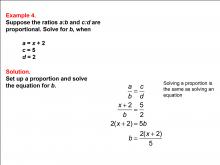
|
Math Example--Ratios, Proportions, and Percents--Solving Proportions: Example 4 | Math Example--Ratios, Proportions, and Percents--Solving Proportions: Example 4TopicRatios, Proportions, and Percents DescriptionThis example illustrates solving for b in a proportion where a is expressed as x + 2, and c and d are given constants (c = 5, d = 2). We set up the equation (x + 2) / b = 5 / 2 and solve for b, resulting in the expression b = (2(x + 2)) / 5. This problem demonstrates how to handle algebraic expressions in proportions. |
Proportions |
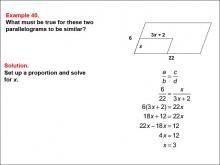
|
Math Example--Ratios, Proportions, and Percents--Solving Proportions: Example 40 | Math Example--Ratios, Proportions, and Percents--Solving Proportions: Example 40TopicRatios, Proportions, and Percents DescriptionThis example demonstrates solving a proportion problem using similar parallelograms with algebraic expressions. Two parallelograms are shown, one with side lengths of 6 and x, and the other with expressions of 3x + 2 and 22. The problem requires setting up a proportion to determine the value of x for which the parallelograms are similar: 6 / 22 = x / (3x + 2). Solving this equation leads to x = 3. |
Proportions |
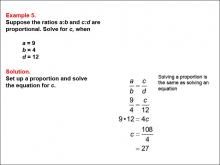
|
Math Example--Ratios, Proportions, and Percents--Solving Proportions: Example 5 | Math Example--Ratios, Proportions, and Percents--Solving Proportions: Example 5TopicRatios, Proportions, and Percents DescriptionThis example demonstrates solving for c in a proportion where a = 9, b = 4, and d = 12. We set up the proportion 9 / 4 = c / 12 and solve for c, resulting in c = 27. This problem shows how to find an unknown value in the numerator of a proportion. |
Proportions |
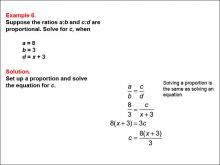
|
Math Example--Ratios, Proportions, and Percents--Solving Proportions: Example 6 | Math Example--Ratios, Proportions, and Percents--Solving Proportions: Example 6TopicRatios, Proportions, and Percents DescriptionThis example illustrates solving for c in a proportion where a = 8, b = 3, and d is expressed as x + 3. We set up the equation 8 / 3 = c / (x + 3) and solve for c, resulting in the expression c = (8(x + 3)) / 3. This problem demonstrates how to handle algebraic expressions in the denominator of a proportion. |
Proportions |
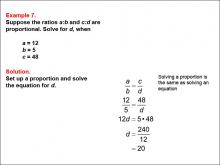
|
Math Example--Ratios, Proportions, and Percents--Solving Proportions: Example 7 | Math Example--Ratios, Proportions, and Percents--Solving Proportions: Example 7TopicRatios, Proportions, and Percents DescriptionThis example demonstrates solving for d in a proportion where a = 12, b = 5, and c = 48. We set up the proportion 12 / 5 = 48 / d and solve for d, resulting in d = 20. This problem shows how to find an unknown value in the denominator of a proportion when all other values are known. |
Proportions |
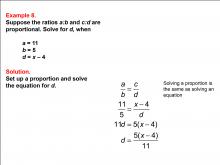
|
Math Example--Ratios, Proportions, and Percents--Solving Proportions: Example 8 | Math Example--Ratios, Proportions, and Percents--Solving Proportions: Example 8TopicRatios, Proportions, and Percents DescriptionThis example illustrates solving for d in a proportion where a = 11, b = 5, and c is expressed as x - 4. We set up the equation 11 / 5 = (x - 4) / d and solve for d, resulting in the expression d = (5(x - 4)) / 11. This problem demonstrates how to handle algebraic expressions in the numerator of a proportion. |
Proportions |
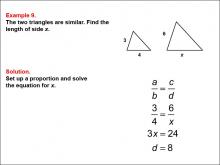
|
Math Example--Ratios, Proportions, and Percents--Solving Proportions: Example 9 | Math Example--Ratios, Proportions, and Percents--Solving Proportions: Example 9TopicRatios, Proportions, and Percents DescriptionThis example demonstrates solving a proportion problem using similar triangles. Two triangles are shown, with one having sides of 3 and 4, and the other having sides of 6 and x. The problem requires finding the length of side x by setting up a proportion based on the similar triangles: 3 / 4 = 6 / x. Solving this equation leads to x = 8. |
Proportions |
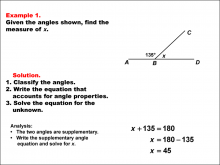
|
Math Example--Solving Equations--Solving Equations Using Angle Properties: Example 1 | Solving Equations Using Angle Properties: Example 1TopicEquations DescriptionThis example demonstrates solving equations using angle properties, specifically focusing on supplementary angles. Supplementary angles are two angles that add up to 180 degrees. In this case, we have one known angle of 135° and an unknown angle x. To solve such equations, we use the fundamental property of supplementary angles: their sum equals 180°. |
Applications of Equations and Inequalities and Definition of an Angle |
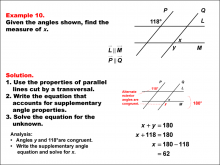
|
Math Example--Solving Equations--Solving Equations Using Angle Properties: Example 10 | Solving Equations Using Angle Properties: Example 10TopicEquations DescriptionThis example illustrates solving equations using angle properties, focusing on parallel lines cut by a transversal and supplementary angles. When parallel lines are cut by a transversal, pairs of supplementary angles are formed, meaning they sum to 180°. In this scenario, we have one known angle of 118° and an unknown angle x. However, angle y and the 118° angle are alternate exterior angles, which are congruent. This means we can set up this equation using the property of supplementary angles: 118 + x = 180 |
Applications of Equations and Inequalities and Definition of an Angle |

|
Math Example--Solving Equations--Solving Equations Using Angle Properties: Example 2 | Solving Equations Using Angle Properties: Example 2TopicEquations DescriptionThis example illustrates solving equations using angle properties, focusing on supplementary angles. Supplementary angles are two angles that sum to 180 degrees. In this scenario, we have one known angle of 75° and an unknown angle x. The equation for supplementary angles is always in the form: angle1 + angle2 = 180°. Here, we can write 75 + x = 180. To solve for x, we subtract 75 from both sides: x = 180 - 75, giving us x = 105°. |
Applications of Equations and Inequalities and Definition of an Angle |

|
Math Example--Solving Equations--Solving Equations Using Angle Properties: Example 3 | Solving Equations Using Angle Properties: Example 3TopicEquations DescriptionThis example demonstrates solving equations using angle properties, specifically focusing on straight angles and vertical angles. A straight angle measures 180°, and vertical angles are always congruent. In this scenario, we have two known angles (36° and 72°) and an unknown angle x. This unknown angle x is vertical (and therefore congruent) to angle z. The angles 36, 72, and z form a straight, but since z is congruent to x, we can write the sum of this straight angle: x + 36 + 72 = 180 x = 72° |
Applications of Equations and Inequalities and Definition of an Angle |
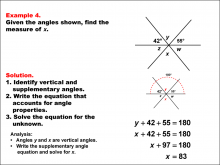
|
Math Example--Solving Equations--Solving Equations Using Angle Properties: Example 4 | Solving Equations Using Angle Properties: Example 4TopicEquations DescriptionThis example illustrates solving equations using angle properties, focusing on straight angles and vertical angles. A straight angle measures 180°, and vertical angles are always congruent. In this scenario, we have two known angles (42° and 55°) and an unknown angle x. However, angle x is vertical (and therefore congruent) to angle y. The equation can be set up based on the fact that the sum of angles on a straight line is 180°. Thus, we have: 42 + 55 + x = 180 |
Applications of Equations and Inequalities and Definition of an Angle |
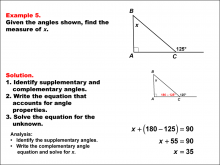
|
Math Example--Solving Equations--Solving Equations Using Angle Properties: Example 5 | Solving Equations Using Angle Properties: Example 5TopicEquations DescriptionThis example demonstrates solving equations using angle properties, specifically focusing on complementary angles and the exterior angle theorem. Complementary angles are two angles that sum to 90°, while the exterior angle theorem states that an exterior angle of a triangle is equal to the sum of the two non-adjacent interior angles. In this scenario, we have a right angle (90°), an exterior angle (125°), and an unknown angle x. Using the exterior angle theorem, we can set up the equation: x + 90 = 125. To solve for x, we subtract 90 from both sides: x = 35°. |
Applications of Equations and Inequalities and Definition of an Angle |
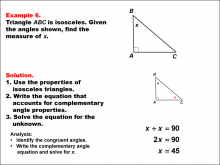
|
Math Example--Solving Equations--Solving Equations Using Angle Properties: Example 6 | Solving Equations Using Angle Properties: Example 6TopicEquations DescriptionThis example illustrates solving equations using angle properties, focusing on an isosceles right triangle. An isosceles right triangle has a right angle (90°) and two equal angles. In this scenario, we have the right angle given, and the two unknown equal angles represented by x. The equation can be set up based on the fact that the sum of angles in a triangle is 180°. Thus, we have: 90 + x + x = 180, or simplified, 90 + 2x = 180 To solve for x, we first subtract 90 from both sides: 2x = 90. Then, dividing both sides by 2, we get: x = 45°. |
Applications of Equations and Inequalities and Definition of an Angle |
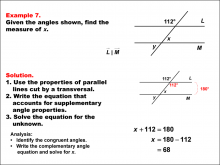
|
Math Example--Solving Equations--Solving Equations Using Angle Properties: Example 7 | Solving Equations Using Angle Properties: Example 7TopicEquations DescriptionThis example demonstrates solving equations using angle properties, specifically focusing on parallel lines cut by a transversal and same side interior angles. When parallel lines are cut by a transversal, same side interior angles are supplementary, meaning they sum to 180°. In this scenario, we have one known angle of 112° and an unknown angle x. The 112° angle is vertical to the same side interior angle paired with x. The equation can be set up as: 112 + x = 180 |
Applications of Equations and Inequalities and Definition of an Angle |

|
Math Example--Solving Equations--Solving Equations Using Angle Properties: Example 8 | Solving Equations Using Angle Properties: Example 8TopicEquations DescriptionThis example illustrates solving equations using angle properties, focusing on parallel lines cut by a transversal and alternate interior angles. When parallel lines are cut by a transversal, alternate interior angles are congruent, meaning they have the same measure. In this scenario, we have one known angle of 48° and an unknown angle x. Since x and y are alternate interior angles, they are congruent. We can now use the property of supplementary angles to solve for x: x + 48 = 180 x = 132° |
Applications of Equations and Inequalities and Definition of an Angle |

|
Math Example--Solving Equations--Solving Equations Using Angle Properties: Example 9 | Solving Equations Using Angle Properties: Example 9TopicEquations DescriptionThis example demonstrates solving equations using angle properties, specifically focusing on parallel lines cut by a transversal and alternate interior angles. When parallel lines are cut by a transversal, alternate interior angles are congruent, meaning they have the same measure. In this scenario, we have one known angle of 43° and an unknown angle x. However, angle x and angle y are alternate interior angles and are congruent. This means that x and teh 43° angle are same side interior angles, which are supplementary. We set up this equation: |
Definition of an Angle and Applications of Equations and Inequalities |
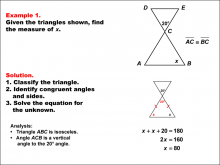
|
Math Example--Solving Equations--Solving Equations Using Triangle Properties: Example 1 | Solving Equations Using Triangle Properties: Example 1TopicEquations DescriptionThis example focuses on solving equations using the properties of similar isosceles triangles. Isosceles triangles are characterized by having two equal sides and two equal base angles. In this case, we have two similar isosceles triangles, which means they share the same shape but may differ in size. The equation to be solved involves finding the unknown angle x, given that one of the angles is 20°. The property of vertical angles tells us that the angle vertical to the 20° angle is also 20° |
Applications of Equations and Inequalities and Applications of Triangles |
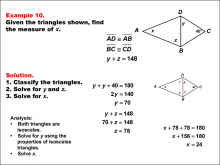
|
Math Example--Solving Equations--Solving Equations Using Triangle Properties: Example 10 | Solving Equations Using Triangle Properties: Example 10TopicEquations DescriptionThis example, similar to Example 9, involves solving equations using the properties of a kite and applying the exterior angle theorem. We are again given one angle of 40° and two unknown angles, y and x. The goal is to set up and solve equations to find the values of y and x using the properties of kites and the exterior angle theorem. Key properties to consider: |
Applications of Equations and Inequalities and Applications of Triangles |
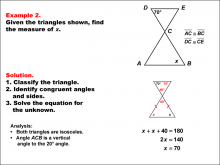
|
Math Example--Solving Equations--Solving Equations Using Triangle Properties: Example 2 | Solving Equations Using Triangle Properties: Example 2TopicEquations DescriptionThis example explores solving equations using the properties of similar isosceles triangles, building upon the concepts introduced in Example 1. In this case, we have two similar isosceles triangles with one known angle of 70° and an unknown angle x. The goal is to determine the value of x using triangle properties and algebraic techniques. |
Applications of Equations and Inequalities and Applications of Triangles |
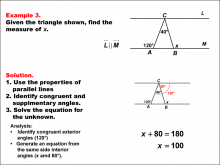
|
Math Example--Solving Equations--Solving Equations Using Triangle Properties: Example 3 | Solving Equations Using Triangle Properties: Example 3TopicEquations DescriptionThis example focuses on solving equations involving parallel lines cut by a transversal, a fundamental concept in geometry. The problem presents two parallel lines intersected by two transversals that also form a triangle. We are given that one angle measures 120° and the corresponding angle can be expressed as (y + 40)°. The goal is to determine the value of y using the properties of angles formed by parallel lines and a transversal. When parallel lines are cut by a transversal, several important angle relationships are formed: |
Applications of Equations and Inequalities and Applications of Triangles |
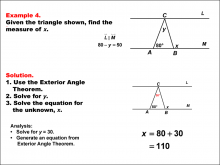
|
Math Example--Solving Equations--Solving Equations Using Triangle Properties: Example 4 | Solving Equations Using Triangle Properties: Example 4TopicEquations DescriptionThis example demonstrates solving equations using the Exterior Angle Theorem in the context of parallel lines cut by a transversal, two crucial concepts in geometry. The problem presents a triangle with two known interior angles of 80° and y, and an unknown exterior angle x°. We are also given that 80 - y = 50, which simplifies to y = 30. The goal is to determine the value of x using the properties of triangles and the Exterior Angle Theorem. The Exterior Angle Theorem states that an exterior angle of a triangle is equal to the sum of the two non-adjacent interior angles. Wo we get x = 80 + 30, or x = 110. |
Applications of Equations and Inequalities and Applications of Triangles |
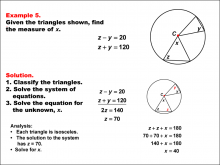
|
Math Example--Solving Equations--Solving Equations Using Triangle Properties: Example 5 | Solving Equations Using Triangle Properties: Example 5TopicEquations DescriptionThis example focuses on solving equations involving isosceles triangles centered in a circle. The problem presents two equations: z - y = 20 and z + y = 120, where z and y represent angles in the isosceles triangles. The goal is to solve this system of equations to find the values of z and y, utilizing properties of isosceles triangles and circles. |
Applications of Equations and Inequalities and Applications of Triangles |
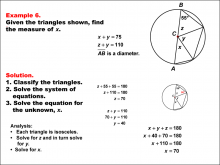
|
Math Example--Solving Equations--Solving Equations Using Triangle Properties: Example 6 | Solving Equations Using Triangle Properties: Example 6TopicEquations DescriptionThis example explores solving equations involving triangles that share a vertex at the center of a circle. We are presented with two equations: x + y = 75 and z + y = 110, where x, y, and z represent angles in the triangle The goal is to solve this system of equations to find the values of x, y, and z, utilizing properties of isosceles triangles. Since each of the triangles is isosceles, we know that z + 55 + 55 = 180 and therefore, z = 70°. We substitute this into one of the equations: 70 + y = 110 7 = 40° |
Applications of Equations and Inequalities and Applications of Triangles |
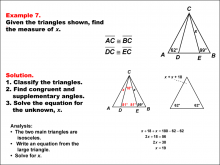
|
Math Example--Solving Equations--Solving Equations Using Triangle Properties: Example 7 | Solving Equations Using Triangle Properties: Example 7TopicEquations DescriptionThis example focuses on solving equations involving isosceles triangles with a common vertex and base. We are given two angles, 62° and 99°, and need to find the unknown angle x. This problem demonstrates how to use the properties of isosceles triangles and the sum of angles in a triangle to solve for an unknown angle. Key properties to consider: |
Applications of Equations and Inequalities and Applications of Triangles |
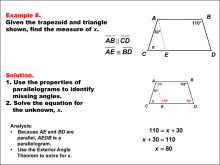
|
Math Example--Solving Equations--Solving Equations Using Triangle Properties: Example 8 | Solving Equations Using Triangle Properties: Example 8TopicEquations DescriptionThis example involves solving an equation using the properties of a trapezoid with an embedded parallelogram and applying the exterior angle theorem. We are given two angles, 30° and 110°, and need to find the unknown angle x. This problem demonstrates the application of multiple geometric concepts to solve a complex equation. Key properties to consider: |
Applications of Equations and Inequalities and Applications of Triangles |
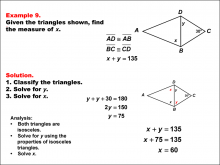
|
Math Example--Solving Equations--Solving Equations Using Triangle Properties: Example 9 | Solving Equations Using Triangle Properties: Example 9TopicEquations DescriptionThis example focuses on solving equations using the properties of a kite and applying the exterior angle theorem. We are given one angle of 30° and two unknown angles, y and x. The goal is to set up and solve equations to find the values of y and x using the properties of kites and the exterior angle theorem. Key properties to consider: |
Applications of Equations and Inequalities and Applications of Triangles |
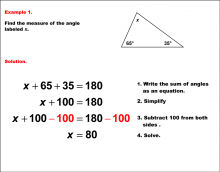
|
Math Example--Solving Equations--Solving Equations with Angle Measures--Example 1 | Solving Equations with Angle Measures--Example 1TopicEquations |
Solving Multistep Equations and Applications of Angles and Planes |

|
Math Example--Solving Equations--Solving Equations with Angle Measures--Example 10 | Solving Equations with Angle Measures--Example 10TopicEquations |
Solving Multistep Equations and Applications of Angles and Planes |
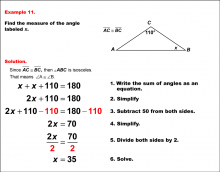
|
Math Example--Solving Equations--Solving Equations with Angle Measures--Example 11 | Solving Equations with Angle Measures--Example 11TopicEquations |
Solving Multistep Equations and Applications of Angles and Planes |
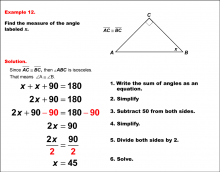
|
Math Example--Solving Equations--Solving Equations with Angle Measures--Example 12 | Solving Equations with Angle Measures--Example 12TopicEquations |
Solving Multistep Equations and Applications of Angles and Planes |
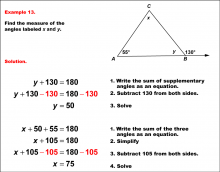
|
Math Example--Solving Equations--Solving Equations with Angle Measures--Example 13 | Solving Equations with Angle Measures--Example 13TopicEquations |
Solving Multistep Equations and Applications of Angles and Planes |
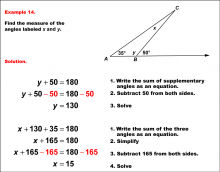
|
Math Example--Solving Equations--Solving Equations with Angle Measures--Example 14 | Solving Equations with Angle Measures--Example 14TopicEquations |
Solving Multistep Equations and Applications of Angles and Planes |

|
Math Example--Solving Equations--Solving Equations with Angle Measures--Example 15 | Solving Equations with Angle Measures--Example 15TopicEquations |
Solving Multistep Equations and Applications of Angles and Planes |

|
Math Example--Solving Equations--Solving Equations with Angle Measures--Example 2 | Solving Equations with Angle Measures--Example 2TopicEquations |
Solving Multistep Equations and Applications of Angles and Planes |
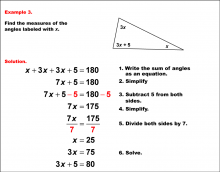
|
Math Example--Solving Equations--Solving Equations with Angle Measures--Example 3 | Solving Equations with Angle Measures--Example 3TopicEquations |
Solving Multistep Equations and Applications of Angles and Planes |

|
Math Example--Solving Equations--Solving Equations with Angle Measures--Example 4 | Solving Equations with Angle Measures--Example 4TopicEquations |
Solving Multistep Equations and Applications of Angles and Planes |
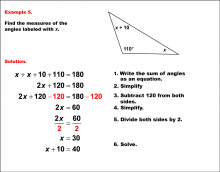
|
Math Example--Solving Equations--Solving Equations with Angle Measures--Example 5 | Solving Equations with Angle Measures--Example 5TopicEquations |
Solving Multistep Equations and Applications of Angles and Planes |
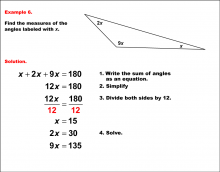
|
Math Example--Solving Equations--Solving Equations with Angle Measures--Example 6 | Solving Equations with Angle Measures--Example 6TopicEquations |
Solving Multistep Equations and Applications of Angles and Planes |

|
Math Example--Solving Equations--Solving Equations with Angle Measures--Example 7 | Solving Equations with Angle Measures--Example 7TopicEquations |
Solving Multistep Equations and Applications of Angles and Planes |
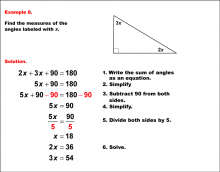
|
Math Example--Solving Equations--Solving Equations with Angle Measures--Example 8 | Solving Equations with Angle Measures--Example 8TopicEquations |
Solving Multistep Equations and Applications of Angles and Planes |
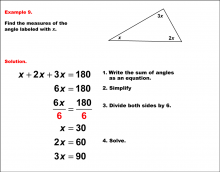
|
Math Example--Solving Equations--Solving Equations with Angle Measures--Example 9 | Solving Equations with Angle Measures--Example 9TopicEquations |
Solving Multistep Equations and Applications of Angles and Planes |
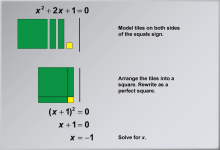
|
Math Example: Solving Quadratic Equations with Algebra Tiles--Example 1 | Math Example: Solving Quadratic Equations with Algebra TilesTopicSolving Equations DescriptionIn this example, we explore solving the quadratic equation x2 + 2x + 1 = 0 using algebra tiles. The visual representation shows how to rearrange the equation into (x + 1)2 = 0, demonstrating the power of algebra tiles in simplifying complex equations. By arranging the tiles, students can physically see the relationship between the terms and understand how they combine to form a perfect square trinomial. |
Quadratic Equations and Functions |
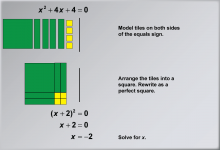
|
Math Example: Solving Quadratic Equations with Algebra Tiles--Example 2 | Math Example: Solving Quadratic Equations with Algebra TilesTopicSolving Equations DescriptionThis example illustrates the process of solving the quadratic equation x2+ 4x + 4 = 0 using algebra tiles. The visual representation demonstrates how to rearrange the equation into (x + 2)2 = 0, showcasing the power of algebra tiles in simplifying and solving quadratic equations. By arranging the tiles, students can physically see how the terms combine to form a perfect square trinomial, making the solution process more intuitive. |
Quadratic Equations and Functions |
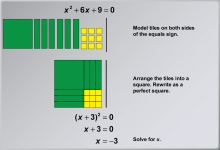
|
Math Example: Solving Quadratic Equations with Algebra Tiles--Example 3 | Math Example: Solving Quadratic Equations with Algebra TilesTopicSolving Equations DescriptionThis example demonstrates the process of solving the quadratic equation x2 + 6x + 9 = 0 using algebra tiles. The visual representation shows how to rearrange the equation into (x + 3)2 = 0, illustrating the power of algebra tiles in simplifying and solving quadratic equations with larger coefficients. By arranging the tiles into a square, students can physically see how the terms combine to form a perfect square trinomial, making the solution process more intuitive and accessible. |
Quadratic Equations and Functions |